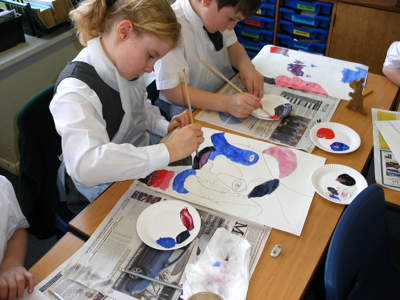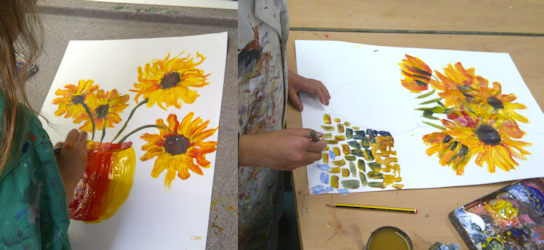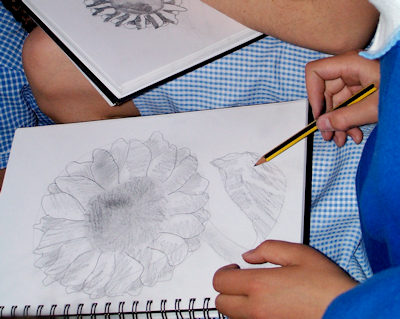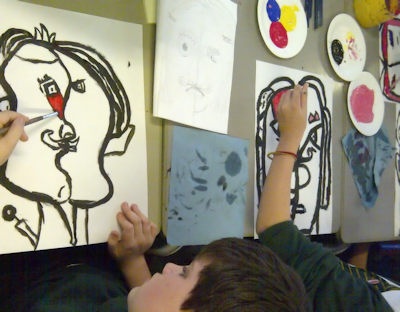Hints and Tips for New Primary Art Coordinators
My Background
Having taught in secondary schools for many years before setting up my own art business, I have learnt a great deal about teaching art to children. Now my art business takes me into many primary schools where I meet a lot of art co-ordinators. Unlike their secondary school counterparts they have to teach many other subjects and in some case, may have little or no art training. This short article is intended to offer a few pointers for those art co-ordinators, or art leader who have been ‘thrown in at the deep end’.
Where to Start as Art Leader
Try a little ‘empire building’ see the boss – the headteacher -and try to get a central store set up where the majority of art materials can be kept. As art leader, you will them have an idea of how much stock you have and can set up systems to keep control of it. Materials spread around a school can be a nightmare to keep track of. Try not to have a system where staff help themselves. The store will soon end up in a mess and someone is always going to take more than their fair share. Nor is it suitable to change the store into Fort Knox, try to find a system that works for you and the rest of the school.
What your Art Dept. Needs
As art co-ordinator you need to take the lead and insist on the following:
- Paint brushes are for painting with; they are NOT for using with glue. Something else has to be found to apply glue.
- Buy bristle based brushes especially for young children who are likely to ‘abuse’ them. A range of bristle brushes of different sizes, both flats and rounds are ideal in primary schools. Most soft haired brushes – usually made from squirrel hair – I come across in primary schools are very poor quality. I would suggest buying a class set of reasonable quality watercolour brushes – the college ranges produced by Winsor Newton, Daler Rowney would be fine – and keep these for older children who can be taught to use them properly.
- As regards brushes try to encourage staff to encourage children not to ‘scrub’ with a paint brush, it will spread the hairs of the brush – but to stroke with the brush in a movement similar to stroking a cat. Children should not hold a long handled brush by the ferrule – the metal bit – but on the widest part of the handle, that way their hands can move freely when painting.
- Try to encourage staff to use only primary colours with maybe white and dark brown with children initially. Encourage children to mix secondary colours cleanly and to create as many tones and tints of those colours as they can. If children are given green paint anything that is green will be painted with that green and no attempt will be made to mix different greens.
- Encourage staff to use the same methods when mixing paints, cleaning brushes, clearing away etc. so the children become familiar with the systems of painting.
- The way rooms are set up for painting should again be consistent around the school, whether this is newspaper on tables or not, whether children wear aprons/old shirts or not, how tables are organised with water pots, palettes, brushes etc. Children should feel that their art lesson is just as important as any other lesson.
Teaching art
Try, where ever possible, to get children to draw either from observation or imagination and not to copy photographs, or paintings of old masters. When drawing from observation talk to children about relationships between objects, one being larger, smaller, fatter, thinner etc, than another. Try to get the children to take account of this in their drawings. As art leader, you might suggest colleagues teaching art might look at my YouTube Channel. They will find lots of step by step videos showing children how to draw.
School Wide Art Aims
Encourage children not to use the word ‘can’t’. As children mature it is difficult to get them to accept their work as being of value. They tend to want to ‘get it right’ and will be dismissive of their own work, if they don’t. Maybe, showing them work by Picasso will help. If you can get hold of images of his paintings and drawings done when he was a teenager and compare them with his later work, it is enlightening. He moved from very detailed academic drawing to much freer, bolder more dramatic work, much more exciting. He once said that he had ‘spent a lifetime trying to draw like a child.’
Finally, some staff feel very reluctant to involve themselves with art in the classroom through a perceived lack of knowledge or ability, or in a few cases, simply use an art lesson as a ‘reward’ for success elsewhere. It is difficult to get some staff to see the value of art teaching. So it might be worth considering getting an artist into school to work with staff during a training day. Someone who could show staff how to use simple shapes and ideas to create drawings, how to mix colours, apply paint, and set up scenario’s in which children can be creative, would give staff confidence. Confidence is the key to success in any endeavour and so it is with the teaching of art.
Check out my YouTube Channel
for great How to Draw tutorials designed for children










Comments
No comment yet.